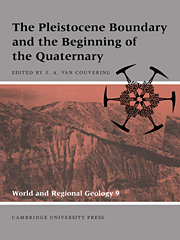Book contents
- Frontmatter
- Contents
- List of contributors
- Preface: the new Pleistocene
- Foreword
- Part I Definition of the base of the Quaternary
- Part II Characterization of the Pleistocene boundary-stratotype
- Part III The paleontological context of the Pleistocene boundary
- Part IV The Pleistocene boundary in regional sequences
- 11 The Pliocene–Pleistocene boundary in Italy
- 12 Stratigraphy of the Plio–Pleistocene sequence of the Mediterranean coastal belt of Israel and its implications for the evolution of the Nile Cone
- 13 The Pliocene–Pleistocene transition in the Iberian Peninsula
- 14 Biostratigraphy and calibrated climatic chronology of the Upper Pliocene and Lower Pleistocene of France
- 15 The Plio–Pleistocene of England and Iceland
- 16 The Neogene–Ouaternary boundary in The Netherlands
- 17 The Tertiary–Quaternary boundary in western Germany
- 18 The Pliocene–Pleistocene boundary in eastern Germany
- 19 The Plio–Pleistocene of Hungary
- 20 The Pliocene–Pleistocene boundary in Romania
- 21 The Pliocene and Pleistocene of the European part of the Commonwealth of Independent States
- 22 The N/Q boundary in Asian Russia and Tadjikistan
- 23 The Pliocene–Pleistocene boundary in the Indian subcontinent
- 24 The Pliocene–Pleistocene boundary in Japan: the Osaka Group, Kinki district
- 25 The Pliocene–Pleistocene boundary in Japan: stratigraphy in the Boso Peninsula, central Japan
- 26 The base of the Quaternary in China
- 27 Plio–Pleistocene deposits and the Quaternary boundary in sub-Saharan Africa
- 28 Plio–Pleistocene reference sections in Indonesia
- 29 The Pliocene–Pleistocene boundary in New Zealand
- 30 The Pliocene–Pleistocene boundary in continental sequences of North America
- Index
26 - The base of the Quaternary in China
Published online by Cambridge University Press: 10 November 2009
- Frontmatter
- Contents
- List of contributors
- Preface: the new Pleistocene
- Foreword
- Part I Definition of the base of the Quaternary
- Part II Characterization of the Pleistocene boundary-stratotype
- Part III The paleontological context of the Pleistocene boundary
- Part IV The Pleistocene boundary in regional sequences
- 11 The Pliocene–Pleistocene boundary in Italy
- 12 Stratigraphy of the Plio–Pleistocene sequence of the Mediterranean coastal belt of Israel and its implications for the evolution of the Nile Cone
- 13 The Pliocene–Pleistocene transition in the Iberian Peninsula
- 14 Biostratigraphy and calibrated climatic chronology of the Upper Pliocene and Lower Pleistocene of France
- 15 The Plio–Pleistocene of England and Iceland
- 16 The Neogene–Ouaternary boundary in The Netherlands
- 17 The Tertiary–Quaternary boundary in western Germany
- 18 The Pliocene–Pleistocene boundary in eastern Germany
- 19 The Plio–Pleistocene of Hungary
- 20 The Pliocene–Pleistocene boundary in Romania
- 21 The Pliocene and Pleistocene of the European part of the Commonwealth of Independent States
- 22 The N/Q boundary in Asian Russia and Tadjikistan
- 23 The Pliocene–Pleistocene boundary in the Indian subcontinent
- 24 The Pliocene–Pleistocene boundary in Japan: the Osaka Group, Kinki district
- 25 The Pliocene–Pleistocene boundary in Japan: stratigraphy in the Boso Peninsula, central Japan
- 26 The base of the Quaternary in China
- 27 Plio–Pleistocene deposits and the Quaternary boundary in sub-Saharan Africa
- 28 Plio–Pleistocene reference sections in Indonesia
- 29 The Pliocene–Pleistocene boundary in New Zealand
- 30 The Pliocene–Pleistocene boundary in continental sequences of North America
- Index
Summary
Introduction
The Upper Pliocene and Lower Pleistocene sediments in eastern China include various types of deposits, providing an ideal region for study of this part of the geologic record. The cave fillings, loess deposits, and strata of fluviolacustrine, coastal-plain, and marine origin combine to reveal the biological history, topography, climate, and active tectonics during that interval. This chapter presents an overview of the sections that are the most significant for separating the Pliocene and Pleistocene.
Starting in 1949, most Chinese geologists adopted the proposal made at the 1948 XVIII International Geological Congress in London to place the Pliocene–Pleistocene boundary at the first immigration of “cold guests” into the marine faunas of the Mediterranean region, exemplified by the paleontology at the base of the Calabrian Stage of Italy, and to consider that level correlative to the base of the Italian Villafranchian Stage in continental deposits. Because the Plio–Pleistocene vertebrate faunas in China have long been famous and better known (Teilhard de Chardin and Piveteau, 1930) than the marine sequences, the continental Villafranchian concept, rather than the marine Calabrian concept, was widely adopted as the basis for recognition of the base of the Pleistocene in China. It is now recognized that in Italy the earliest Villafranchian is almost twice as old as the base of the Calabrian Stage (Azzaroli et al., Chapter 11, this volume). The Chinese workers have maintained, however, that the Villafranchian definition is in agreement with the first cold-climate faunas of both marine and continental environments in that region, coinciding closely with the Gauss–Matuyama paleomagnetic reversal at about 2.6 Ma.
- Type
- Chapter
- Information
- The Pleistocene Boundary and the Beginning of the Quaternary , pp. 247 - 253Publisher: Cambridge University PressPrint publication year: 1996
- 1
- Cited by



